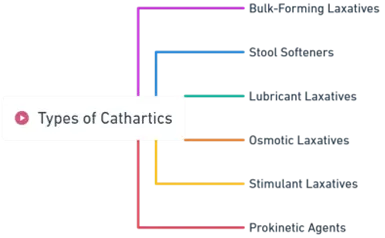Introduction to Cathartics:
- Cathartics, also known as laxatives, are substances that promote bowel movements and relieve constipation.
- They are used in treating various gastrointestinal disorders, including constipation, irritable bowel syndrome (IBS), and for bowel preparation before diagnostic procedures or surgeries.
Types of Cathartics:
This is a sample ad placement!
1) Bulk-Forming Laxatives:
-
- Mechanism: Increase the bulk and water content of the stool, making it easier to pass.
- Examples: Psyllium husk, methylcellulose, calcium polycarbophil.
- Uses: Treat constipation, especially in individuals with low-fiber diets or those who need to avoid straining during bowel movements.
2) Stool Softeners:
-
- Mechanism: Soften the stool by increasing its water content, facilitating easier passage.
- Examples: Docusate sodium, docusate calcium.
- Uses: Suitable for individuals recovering from surgery, childbirth, or those with hemorrhoids or anal fissures.
This is a sample ad placement!
3) Lubricant Laxatives:
-
- Mechanism: Coat the stool and intestinal lining, reducing friction and allowing for easier passage.
- Examples: Mineral oil, liquid paraffin.
- Uses: Provide short-term relief of constipation, particularly for those with difficulty passing hard stools.
4) Osmotic Laxatives:
-
- Mechanism: Draw water into the intestines, softening the stool and increasing intestinal motility.
- Examples: Magnesium hydroxide, magnesium sulfate, lactulose, polyethylene glycol (PEG).
- Uses: Treat constipation, prepare the bowel for diagnostic procedures or surgeries, and manage hepatic encephalopathy (lactulose).
This is a sample ad placement!
5) Stimulant Laxatives:
-
- Mechanism: Stimulate the intestinal muscles to contract, promoting bowel movements.
- Examples: Senna, bisacodyl, castor oil.
- Uses: Provide short-term relief of constipation, bowel preparation for procedures, and occasional use for constipation not responding to other treatments.
6) Prokinetic Agents:
-
- Mechanism: Increase gastrointestinal tract motility by acting on smooth muscles or nerves.
- Examples: Metoclopramide, tegaserod.
- Uses: Treat constipation associated with certain medical conditions (e.g., Parkinson’s disease), gastroparesis, and irritable bowel syndrome with constipation (IBS-C).
This categorization helps in understanding the different mechanisms and appropriate uses of cathartics for various conditions.
This is a sample ad placement!
Thank you for reading from Firsthope's notes, don't forget to check YouTube videos!


